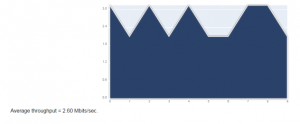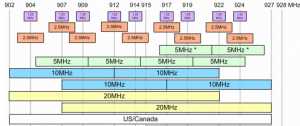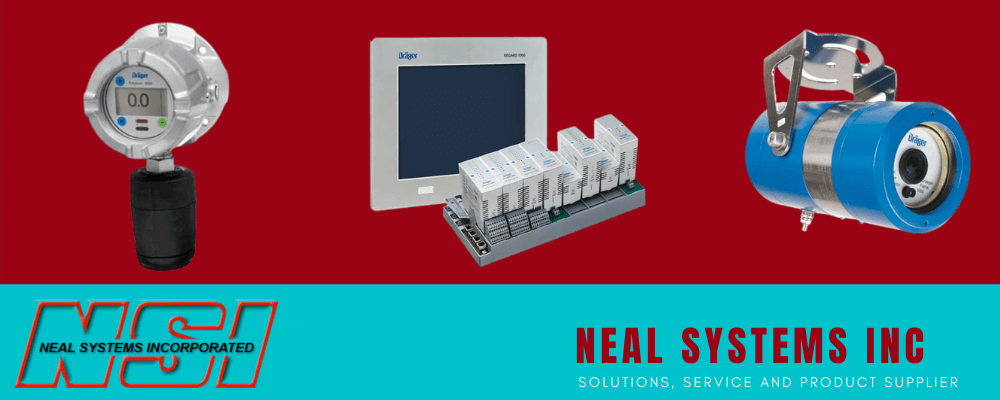October 14, 2020 | Company News
NSI recently performed a wireless survey for a customer wanting to implement Elpro 945U-E radios. The radios operate as wireless ethernet nodes in the 900MHz, license free spectrum, allowing customers to significantly extend their ethernet range without running wires. The site in question needs to bring data back from multiple locations around the plant to a centralized control room and running copper or fiber wires is cost prohibitive.
NSI sent a field service technician to site with a Spectran HF-6065 spectrum analyzer in order to perform a site survey.
A site survey consists of three stages:
1. A topographical and building analysis of the site .
2. A series of background noise checks.
3. A series of radio throughput tests.
The first step uses Google Earth to analyze the topography between each of the radio installation sites. This can be done prior to or after the site visit. Whilst on site, the technician will take photographs of any obstructions such as trees, equipment (moving cranes is a good example) or buildings and locate them with GPS co-ordinates.
The second step utilizes the spectrum analyzer and allows the technician to take 10 minute recordings of all the radio traffic in the frequency bands in question, in this case 902 to 928 MHz. This provides details of average and peak signal strengths but also provides a waterfall graph throughout the entire test period.
Green trace shows peak noise during the analysis period
Blue line shows the average noise during the analysis period

The Waterfall graph shows the background noise over time so x-axis is frequency (902-928MHz), y-axis is time period (10 minutes in this case) and the noise level is shown as a color (color scale is shown on the right hand side).
This graph shows constant transmissions around 902MHz and infrequent transmissions elsewhere in the spectrum (shown with the dark red horizontal bar).

The third step is to perform an iPerf test using two back to back radios that transmit to each other whilst measuring the throughput and the error rate of the received signals. These tests are done to and from the proposed radio installation sites. The tests are performed for ten seconds and are done three times for each pair of location and the results averaged.
The radios record the results of the test and make them available in graph and summary form, looking something like this:

The results of the testing demonstrated that there is significant background noise around the 920MHz range and limited noise elsewhere in the spectrum.
There are 28 available channels to select when configuring the Epro 945U-E radio:
• 9 x non overlapping 1.25-MHz channels
• 9 x partially overlapping 2.5-MHz channels
• 4 x non overlapping 5-MHz channels
• 4 x overlapping 10-MHz channels
• 2 x overlapping 20-MHz channels
In the frequencies shown below:

For any given signal strength the radio throughput halves as the frequency band halves so the 1.25MHz band offers 1/16 the throughput of the 20MHz band. Generally speaking, select the widest channel for which there is no interference.
For the best throughput, the 10MHz channel between 902 and 912 MHz would be selected. For the least interference, the 1.25MHz channels at either 914 or 922 MHz would be selected (these correspond to gaps in the waterfall graph).
Additional features such as whitelisting and blacklisting, encryption, transmit power and fixed noise floor are then configured. Antennas and cable type are selected based on cable run lengths, background noise levels and distance between radios, all whilst staying within the FCC’s 36dB maximum effective radiated power limit.
The biggest mistake that most users make when running into radio communication issues is to simply increase their antenna size. More often than not this does not help.
For more information on wireless and line of sight radios – check out the recent NSI Virtual Training course on “Will it ACTUALLY work? Line-of-Sight Industrial Radios“!
September 21, 2020 | Company News
The NJ Water Association partnered with Neal Systems Inc. will be providing an accredited course: Instruments and Controls for Water and Wastewater Treatment at the Denville Public Works on September 29, 2020. The course is currently filled but registration will allow you to get moved to a cancellation list!
The course accreditations are as followed:
5.0 Training Contact Hours for NJ-Licensed Water/Wastewater Operators. TCH Course# 04-092003-30
5.0 Hours toward license renewal for NJ Certified Public Works Managers: DLGS-NJWA- 202. (5.0 Tech.)
The course is designed for presentation to both beginners and experienced operation and maintenance personnel. Upon completion of the course, students will have a better understanding of how the instruments and control systems in their facility operate and how to identify and troubleshoot problems.
Pete Hutwelker will be instructing the course. Pete has work as a Service Technician, Regional Service Manager, National Service Manager, Product Manager, Systems Engineer and Business Development Manager. Pete was the Founder and General Manager of ES2 Inc. – specializing in Service and Supply of Equipment and Systems to Water, Wastewater and Solid Waste industry. He is currently employed by Neal Systems Inc. – Systems Integrator and supplier of process controls & instrumentation.
To register for the course: CLICK HERE!
September 8, 2020 | Company News

We recently upgraded an industrial facility’s Life Safety System (LSS) from Draeger Polytron XP Tox and Flame 2300 hardware to Drager Polytron 8000 and Flame 5000. At the same time, we removed the 3 associated PLC’s and replaced them with Draeger’s’ new Regard 7000 rack-based system. This system is integrated into a Siemens fire system and that integration was retained.
The plant cannot operate without the LSS being functional, so we had scheduled for a plant shutdown from Friday to Sunday. All of the removal and new installation work was finished by Saturday night with gas system testing done on Sunday. This allowed the plant to operate again on Monday whilst the integration to the fire system was tested.
The new platform provides state of the art functionality in terms of connectivity and diagnostics. Field technicians can now attach their laptops anywhere in the plant and without a need to adjust their IP addresses. The Regard 7000 racks utilize a proprietary ethernet protocol that does not require IP addressing. It is possible to ‘tunnel’ through the IO racks and out to the Polytron 8000 transmitters in order to make adjustments or read diagnostic information.
The Regard 7000 integrates immediately and completely with all Draeger Polytron devices over a HART connection and even integrates to competitive devices using a 4-20mA signal. It supports relay outputs to drive horns and lights and digital inputs to support alarm acknowledge pushbuttons or inhibit switches.
The Regard 7000 supports Modbus TCP slave, so a Samsara IG21 was added to the network to pull data from each of the gas detectors and display it via a cell connection to the cloud on mobile devices for plant management. These are AES256 bit end-to-end encrypted connections that are also used to produce text, email and voice alerts when any gas level goes out of its standard range. In addition, the IG21 allows for NSI to set up a secure VPN tunnel to diagnose any faults securely and remotely, thus providing lower cost and more timely support for our customer.
The Flame 5000 is an explosion proof flame detector that is actually a video camera that uses advanced algorithms to ‘see’ a flame. Welding, hot CO2 emissions and flare reflections do not trigger the alarms but it will detect an n-heptane fire of 0.1m2 at 44m separation. It also supports full color video camera functionality and can record locally to an SD card for before and after event analysis.
September 2, 2020 | Company News
This years WaterJAM will be held virtually! This means you have access to everything WaterJAM from September 14th to October 2nd! Neal Systems will have have a unique presentation titled: Will it work? Modern Wireless Technologies for the Water/Wastewater Industry available throughout those two-weeks.
On Wednesday, September 16th at 11:30AM, Shane Filer and Peter Jackson will be live answering questions about their presentation and will give you an opportunity to learn more about the wireless technologies available!
View more information on WaterJAM and sign-up here!
June 26, 2020 | Company News
Neal System’s engineering team knows how much effort it takes to estimate installed accuracy for a specific pressure application. To reduce the effort of looking up tables in datasheets, our team designed a working spreadsheet calculator to make this process easy. The document allows you to:
- Use a pre-filled drop down menu
- Fill-in style fields to ensure your calculation is correct
- Easily print or place into PDF format for you to add as a record for your project documentation
Download our pressure calculator here!





